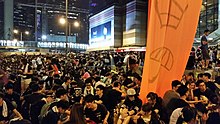This article needs to be updated. The reason given is: Portions of the article are written in the present tense. (July 2019) |
| Date | 28 September – 15 December 2014 (79 days) |
|---|---|
| Location | Admiralty, Mong Kok, Causeway Bay, Hong Kong |
| Also known as | Occupy Central Movement |
| Cause | China's decision to rule out full universal suffrage in Hong Kong |
| Organised by | Civil Disobedience Movement |
| Participants | |
| Umbrella Movement | |||||||||||||||||||
|---|---|---|---|---|---|---|---|---|---|---|---|---|---|---|---|---|---|---|---|
 Umbrella banner, Admiralty, Hong Kong, 29 September 2014 | |||||||||||||||||||
| Traditional Chinese | 雨傘運動 | ||||||||||||||||||
| Simplified Chinese | 雨伞运动 | ||||||||||||||||||
| |||||||||||||||||||
The Umbrella Movement (Chinese: 雨傘運動) was a political movement that emerged during the 2014 Hong Kong protests.[2][3][4] Its name arose from the use of umbrellas as a tool for passive resistance to the Hong Kong Police Force's use of pepper spray to disperse the crowd during a 79-day occupation of the city demanding more transparent elections, which was sparked by the decision of the Standing Committee of the National People's Congress (NPCSC) of the People's Republic of China of 31 August 2014 that prescribed a selective pre-screening of candidates for the 2017 election of Hong Kong's chief executive.[5][6]
The movement consisted of individuals numbering in the tens of thousands who participated in the protests that began on 26 September 2014, although Scholarism, the Hong Kong Federation of Students, Occupy Central with Love and Peace (OCLP) are groups principally driving the demands for the rescission of the NPCSC decision. Since the start of the 2014 protests, movement activists have complained of harassment from political opponents "alarmingly similar to the way mainland Chinese activists and their families have long been targeted"[7] and have been prosecuted and jailed for their participation in acts of protest.
- ^ http://www.hkilang.org/NEW_WEB/page/dictionary Archived 1 July 2015 at the Wayback Machine Association for Conversation of Hong Kong Indigenous Languages Online Dictionary for Hong Kong Hakka and Hong Kong Punti (Weitou dialect)
- ^ Phillips, Keri (28 October 2014). "Tracing the history of Hong Kong's umbrella movement". ABC Radio National. Australian Broadcasting Corporation. Retrieved 29 November 2014.
- ^ Tattersall, Amanda (2019). "An in depth look at the Hong Kong democracy movement". Commons Social Change Library. Retrieved 1 July 2022.
- ^ Lau, Emily (2018). "Umbrella Movement Reflections". Commons Social Change Library. Retrieved 1 July 2022.
- ^ "Beijing rejects full Hong Kong democracy". Deutsche Welle. 31 August 2014. Retrieved 31 August 2014.
- ^ Meixler, Eli (17 January 2018). "Joshua Wong, Hong Kong's Most Prominent Pro-Democracy Activist, Has Been Jailed Again". Time. Retrieved 11 June 2018.
- ^ Cite error: The named reference
20150218csmwas invoked but never defined (see the help page).